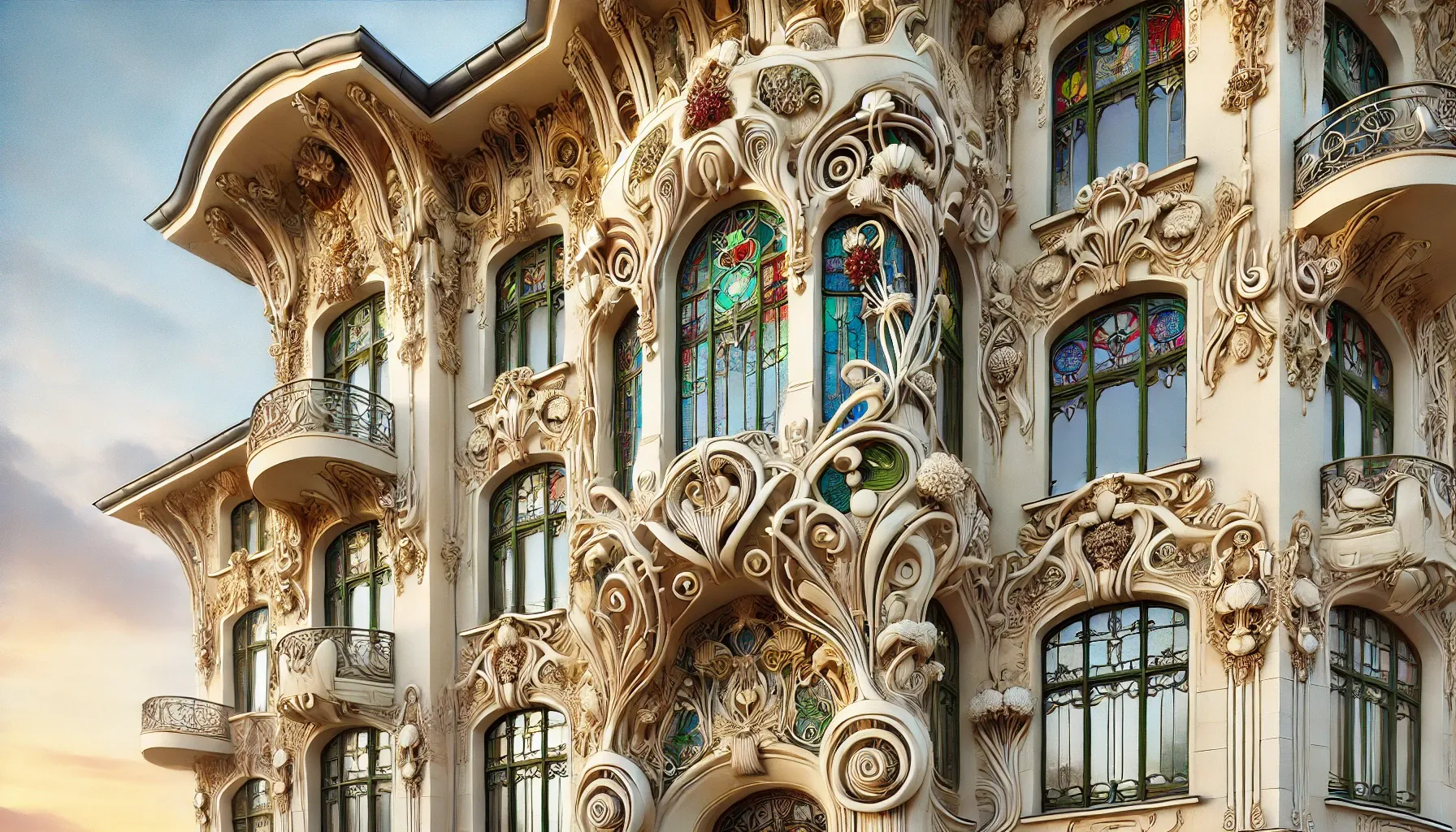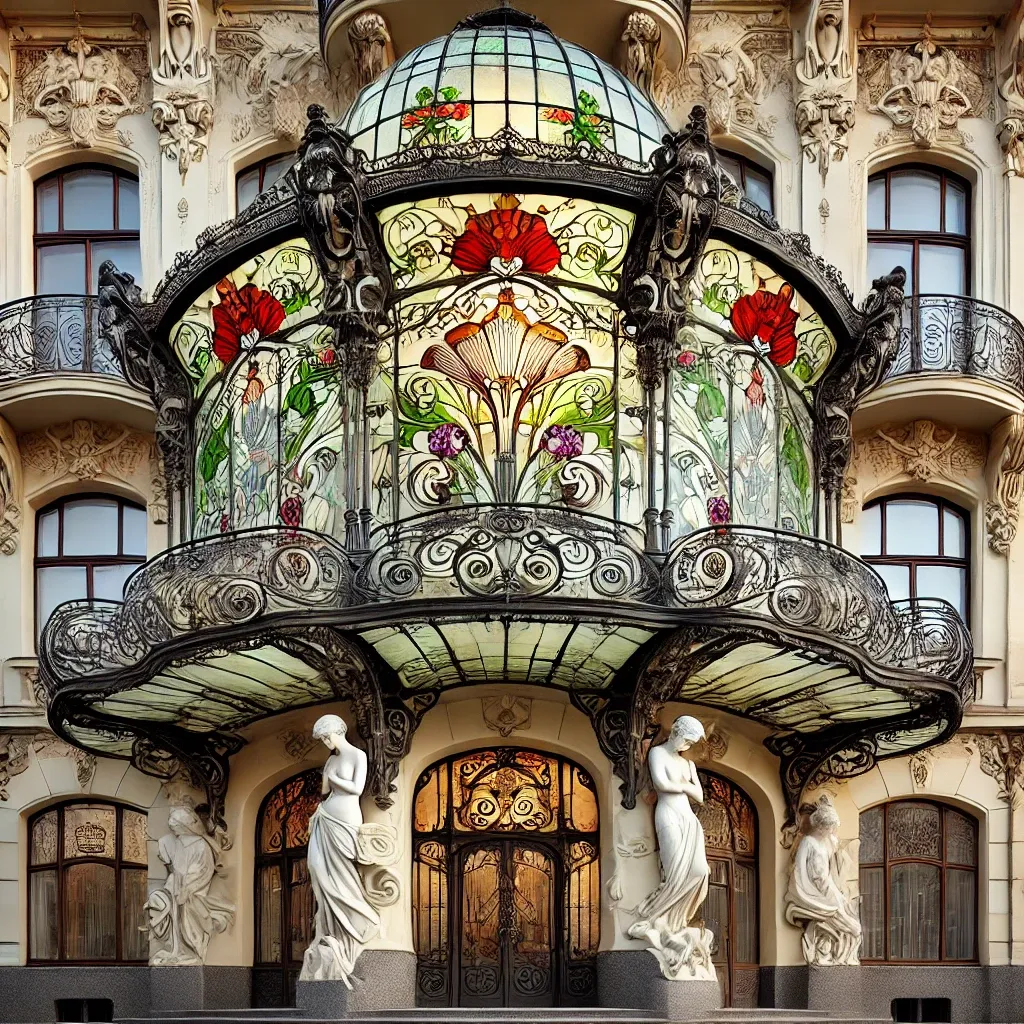Modern: Art and Architecture of the 1890s to 1910s in Europe

- How did modernism change the architectural landscape of Europe and Russia?
- Architectural heritage: the Tassel Hotel and the "Secession" House in Brussels and Vienna
- Architectural masterpieces: the "Secession" building and the Palace of Fine Arts in Mexico
Modernism and its influence
Modernism, also known as Art Nouveau, is an artistic movement that actively developed in European countries between 1890 and 1910. The essence of this style lies in the desire to avoid rigid geometric shapes and lines, which allowed for the creation of smoother and more natural curves, drawing inspiration from the surrounding nature.
In architecture, special attention was given to the use of modern materials such as glass and metal, which allowed for the creation of unique and expressive facades.
The popularity of modernism in Europe
Modernism became particularly widespread in countries such as:
- Austria
- Belgium
- Germany
- Netherlands
- Spain
- Latvia
- Czech Republic
It is interesting to note that in Austria, this direction is called“secession”which translates to "department." At the same time, in Germany, Belgium, and Latvia, it is referred to“Jugendstil”which translates to "youth style".
Famous modern architects
Among the outstanding architects associated with European modernism, we can mention names such as:
- Victor Orta
- Hector Gimara
- Antonio Gaudí
- Otto Wagner
- Mikhail Eisenstein
Their works are often regarded as true masterpieces of architecture and amaze with their artistic expression.
Modernism in Russia
In Russia, you can see many examples of this artistic direction, among which notable structures include:
- The House of Books in St. Petersburg
- The "Metropol" Hotel in Moscow
Other well-known buildings constructed in this style include the Church of the Holy Family and Casa Batlló in Barcelona. Over the more than one hundred years since their construction, many Art Nouveau buildings continue to be a vibrant adornment of the urban landscapes of Europe.
Local government bodies are actively engaged in their protection and restoration, as these architectural monuments attract tourists and art specialists from all over the world. Jugendstil has become an integral part of the appearance of Riga, where you can see eight magnificent buildings designed by Mikhail Eisenstein on Alberta Street.
The House of Leo Morera
The Casa Lleó Morera in Barcelona deserves special attention, as it is a masterpiece of Catalan Modernism. The peak of popularity of this architectural style occurred during the transitional period between the 19th and 20th centuries, particularly in this city. Old Barcelona, filled with the atmosphere of the Middle Ages, experienced the influence of the Industrial Revolution, which significantly enriched the architectural appearance and lifestyle of the city.
The new bourgeoisie, eager to showcase their status, sought to express it through original and refined designs of their homes.
A typical residential building, constructed in 1864 for the family of manufacturer Morera, underwent significant transformation in 1902. Thanks to the outstanding architect Lluís Domènech i Montaner, the facade of this house became a true work of art.
Its walls were adorned with a variety of plaster ornaments, reflecting both heraldic and floral motifs. Large windows, separated by stylish pilasters, made it even more attractive. Additionally, marble columns were placed around the entire perimeter of the building, giving the structure a noble and majestic appearance.
Architectural complex
The architectural ensemble was enhanced with a glass dome and compact balconies adorned with exquisite balusters. An elegant turret rises above the roof of the building.
The famous sculptor was involved in the design of the facade.Eusebi Arnaudwho created elegant sculptures of four girls placed in the side windows. Each of them holds one of the outstanding technical achievements of their time:
- camera
- phone
- phonograph
- incandescent lamp
Unfortunately, the client of the project passed away before the work was completed, and his son,Albert Leo-and-MoreraHe became responsible for the final appearance of the building. In memory of his father, he decided to decorate the facade with images of lions (lleo) and branches of mulberry trees (morera). To this day, this building belongs to the Nunez y Navarro family.
Tassel Hotel in Brussels
As for the Tassel Hotel, located in Brussels, it was built inin 1894on the project of a Belgian scientistEmilia TasselThe architect of this deed wasVictor Orta. Withthe year 2000The Tassel Hotel, along with several of his other creations, including his personal house and workshop, is included in the list of World Heritage sites.UNESCO.
During the design of the building, Victor Horta deviated from the traditional layout schemes that were typical of most Belgian residential houses of that time, even his own.
The structure of the Tassel Hotel
The Tassel Hotel consists of three parts. Two buildings with a classic layout, made of brick and natural stone, are located in different places:
- one building is closer to the street
- the second building — towards the garden
Between these two buildings, Orta created a connecting space — a structure made of a steel frame, clad in glass panels and topped with a transparent roof that allowed sunlight to filter in. This area also features stylish spiral staircases.
In the process of working on the hotel design, Victor Horta showcased his artistry in interior decoration.
9 October 2024
29 September
9 October 2024

- door handles
- window frames
- stained glass
- mosaic on the floors
The architect managed to create a luxurious interior design that harmoniously blended with the overall architectural expression of the entire building.
Exclusive housing
The construction of the Tassel Hotel turned out to be quite an expensive process, and only very wealthy bourgeois could afford such a luxurious residence. That is why such architectural innovations were rarely seen in Brussels, even among buildings erected in the Art Nouveau style.
The "Secession House" in Vienna
The "Secession House" in Vienna, orWiener Secession Buildingwas built inin the years 1897-1898for the eponymous art association. The project for this exhibition pavilion was developed by the architectJosef Maria OlbrichThis building has become one of the most iconic architectural monuments of Austrian modernism.
His unique style and design attract many tourists and architecture enthusiasts, making it an integral part of Vienna's cultural and historical heritage.

The "Secession" Building
In the architectural world, the building in question is most often referred to as "Secession." Its facade, featuring a distinctive style, has even been depicted on the reverse side of the Austrian 50 euro cent coin.
The building stands out with its unique angular shapes, topped by a gilded dome that has earned the nickname "cabbage head" among the people. When looking at the facade, the predominance of plant motifs is noticeable — leafy patterns and tree trunks create an exquisite appearance.
The exterior facade is adorned withgolden inscriptionThe phrase states: "Time is its art, art is its freedom." This motto was adopted by the creators who founded the "Secession" movement, whose works aimed to challenge traditional interpretations of art. Next to the main entrance, you can find another important inscription - ver sacrum ("sacred spring"), which became a symbol of the artists' hopes for a new development in world art.
The decoration of the house was done by several artists, including:
- The three owls on the side facade are the result of the work of Koloman Moser;
- The Gorgon's heads on the doors are the work of the sculptor Otmar Shimkovitz.
Palace of Fine Arts in Mexico
A no less remarkable example of architectural sophistication is the Palace of Fine Arts (Palacio de Bellas Artes) in Mexico. This building, which serves as an opera house, is made of white Carrara marble. The construction of this magnificent structure began in 1904, but the process faced numerous obstacles.
The ground on which the building was erected turned out to be insufficiently strong to support its massiveness. Additionally, a revolution began in the country in 1913, which forced the architect Adamo Boari to leave Mexico and return to Italy. The construction was completed only in 1934, when the project was handed over to a Mexican architect.
The exterior of this building reflects the Art Nouveau style, although it also features elements of Neoclassicism. As for the interior design, one can find an Art Deco atmosphere here.
The facade is decorated:
- Figurines of cherubs;
- Bronze masks symbolizing the element of water;
- Stone sculptures dedicated to the art of music and inspiration.
Special attention should be paid to the details of the crystal roof, which features Apollo surrounded by muses. Upon entering the palace, you can see allegorical sculptures that embody emotions, including:
- “Harmony”
- “Sadness”;
- “Anger”;
- “Happiness”;
- "World";
- “Love.”
Among the frescoes that adorned the walls at the time of the palace's opening, the work of Diego Rivera, "Man at the Crossroads" (El hombre en el cruce de caminos), stands out particularly. This masterpiece is divided into two parts, consisting of:
- Capitalist world;
- Communist ideology.
Between these two parts stands a man operating a huge machine that consumes natural resources and sends them to capitalist factories. One of the representatives of the bourgeoisie depicted unfavorably on the fresco isJohn Davison Rockefellerwhose presence attracts the audience's attention.
Conclusion
As we conclude our fascinating tour of the world of Art Nouveau, we can confidently say that this artistic movement has left a vivid mark on the history of architecture and design. Art Nouveau not only brought natural forms and lines to the forefront, moving away from the strict geometric designs of previous eras, but also reflected the social changes and aspirations of its time. We see how architects such asAntonio GaudíandVictor OrtaThey were not afraid to experiment and implement new ideas, which gave us amazing creations that continue to impress with their aesthetics and harmony to this day.
Studying architectural masterpieces such asThe House of Leo MoreraandTassel HotelI realize that modernism became a symbol of bourgeois growth and cultural flourishing in the early 20th century. These buildings, with their unique shapes and rich decorations, are not just beautiful objects, but also stories from a time when art and life merged into one. They remind us of the importance of valuing the heritage left to us by our predecessors.
The modern influence of modernism
Moreover, modernism continues to influence contemporary art and architecture, inspiring new masters:
- Seek inspiration from nature;
- Experiment with materials;
- Creating a space where every element has its significance.
We can be proud that many buildings in the Art Nouveau style, especially in Europe, are being preserved and restored, allowing future generations to enjoy their grandeur.
Philosophy of the modern era
Thus, studying modernism, I am convinced that it is not just a style, but a true philosophy based on:
- Love for beauty;
- Nature;
- The pursuit of the new.
It remains relevant, reminding us of the importance of artistic self-expression in any era.
Tags
Comment
Popular Posts
9 October 2024
1485
29 September
346
9 October 2024
9934
Popular Offers

Subscribe to the newsletter from Hatamatata.com!
Subscribe to the newsletter from Hatamatata.com!
I agree to the processing of personal data and confidentiality rules of Hatamatata













